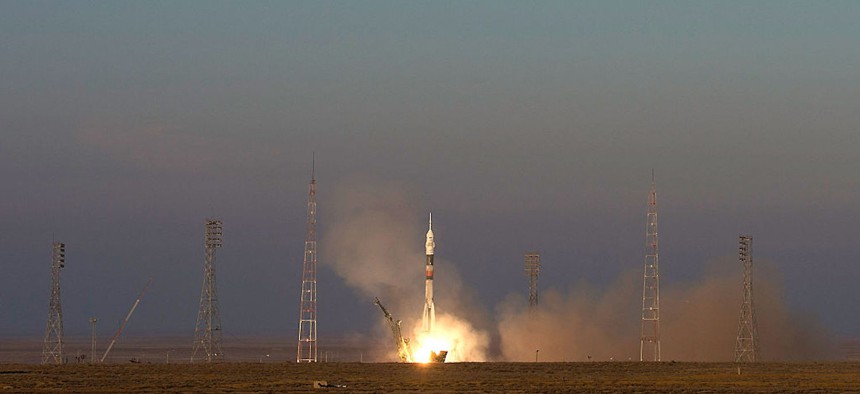
In this 2015 handout image supplied by NASA, Expedition 46-47 crewmembers ESA astronaut Tim Peake, NASA astronaut Tim Kopra and commander Yuri Malenchenko launch into space from Baikonur cosmodrome. NASA / Joel Kowsky via Getty Images
Is Russia putting an anti-satellite nuke in space?
A long-ago U.S. test showed the kind of havoc that could wreak in orbit.
U.S. intelligence officials believe Russia wants to put a nuclear weapon in space, according to multiple reports that emerged Wednesday after the chair of the House Intelligence Committee publicly urged the White House to declassify information about a "destabilizing foreign military capability" constituting a “serious national security threat.”
Following that explosive tweet from Rep. Mike Turner, R-Ohio, news trickled out throughout the day, despite the best efforts of the White House and others to control the flow of information. ABC News cited two unnamed sources as saying the weapon would be intended to disable satellites, not ground targets.
"I am a bit surprised that Congressman Turner came out publicly today in advance of a meeting on the books for me to go sit with him alongside our intelligence and defense professionals tomorrow," National Security Advisor Jake Sullivan told reporters.
Sullivan said the gathering will include the Gang of Eight: the four party leaders in Congress and the leaders of the House and Senate intelligence committees.
Senate Select Committee on Intelligence Chairman Mark Warner, D-Virginia, and Vice Chairman Marco Rubio, R-Fla., released a joint statement saying that their committee had been “rigorously tracking this issue from the start.”
“We continue to take this matter seriously and are discussing an appropriate response with the administration. In the meantime, we must be cautious about potentially disclosing sources and methods that may be key to preserving a range of options for U.S. action,” they said.
The news comes five days after Russia launched a Soyuz-2-1v rocket with a classified military payload.
U.S. officials have been trying to highlight increasingly aggressive Russian space activity for years now, from rogue satellites to space ramming weapons.
Just what could a nuclear weapon in space achieve? A clue comes from Starfish Prime, the 1962 detonation of a 1.4-megaton device some 250 miles above the Pacific Ocean. The U.S. test created a geomagnetic storm that destroyed satellites.
One year later, the United States and other nations signed the Nuclear Test Ban Treaty, which prohibits such experiments.
More recently, the U.S. military has been looking at ways to harden its most important satellites against a nuclear blast in space. One idea would use radio waves to clear the radiation from orbit.
But the effect of such a weapon now would be exponentially greater than in the 1960s due to the massive proliferation of commercial satellites in space. Last year, the Center for Strategic and International Studies offered this description in its Space Threat Assessment: “The use of a nuclear weapon in space would have large-scale, indiscriminate effects that would be attributable and publicly visible. A nuclear detonation in space would immediately affect satellites within range of its EMP, and it would also create a high-radiation environment that would accelerate the degradation of satellite components over the long term for unshielded satellites in the affected orbital regime.”




